DODGE JOURNEY 2010 1.G Manual PDF
Manufacturer: DODGE, Model Year: 2010, Model line: JOURNEY, Model: DODGE JOURNEY 2010 1.GPages: 512
Page 71 of 512
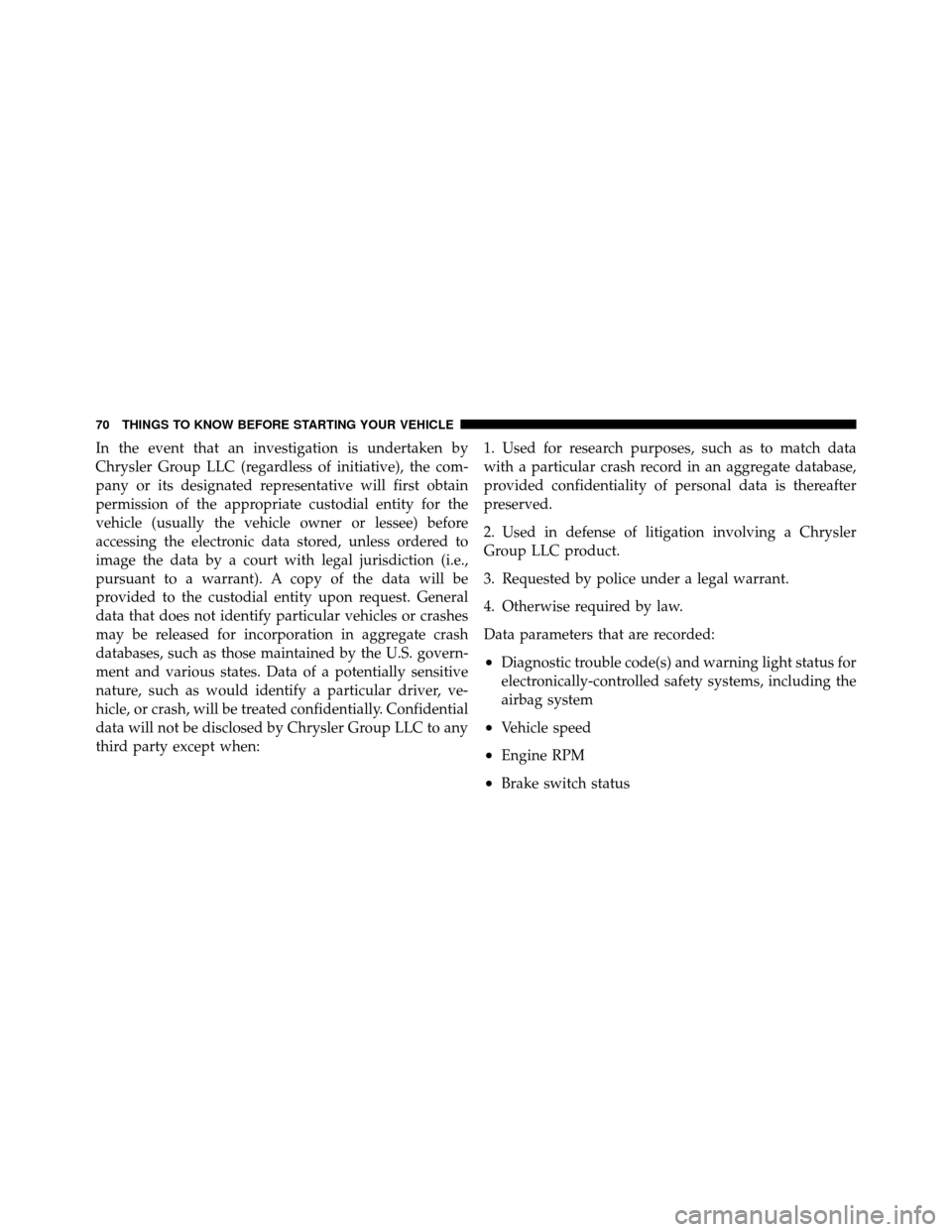
In the event that an investigation is undertaken by
Chrysler Group LLC (regardless of initiative), the com-
pany or its designated representative will first obtain
permission of the appropriate custodial entity for the
vehicle (usually the vehicle owner or lessee) before
accessing the electronic data stored, unless ordered to
image the data by a court with legal jurisdiction (i.e.,
pursuant to a warrant). A copy of the data will be
provided to the custodial entity upon request. General
data that does not identify particular vehicles or crashes
may be released for incorporation in aggregate crash
databases, such as those maintained by the U.S. govern-
ment and various states. Data of a potentially sensitive
nature, such as would identify a particular driver, ve-
hicle, or crash, will be treated confidentially. Confidential
data will not be disclosed by Chrysler Group LLC to any
third party except when:1. Used for research purposes, such as to match data
with a particular crash record in an aggregate database,
provided confidentiality of personal data is thereafter
preserved.
2. Used in defense of litigation involving a Chrysler
Group LLC product.
3. Requested by police under a legal warrant.
4. Otherwise required by law.
Data parameters that are recorded:
•Diagnostic trouble code(s) and warning light status for
electronically-controlled safety systems, including the
airbag system
•Vehicle speed
•Engine RPM
•Brake switch status
70 THINGS TO KNOW BEFORE STARTING YOUR VEHICLE
Page 72 of 512
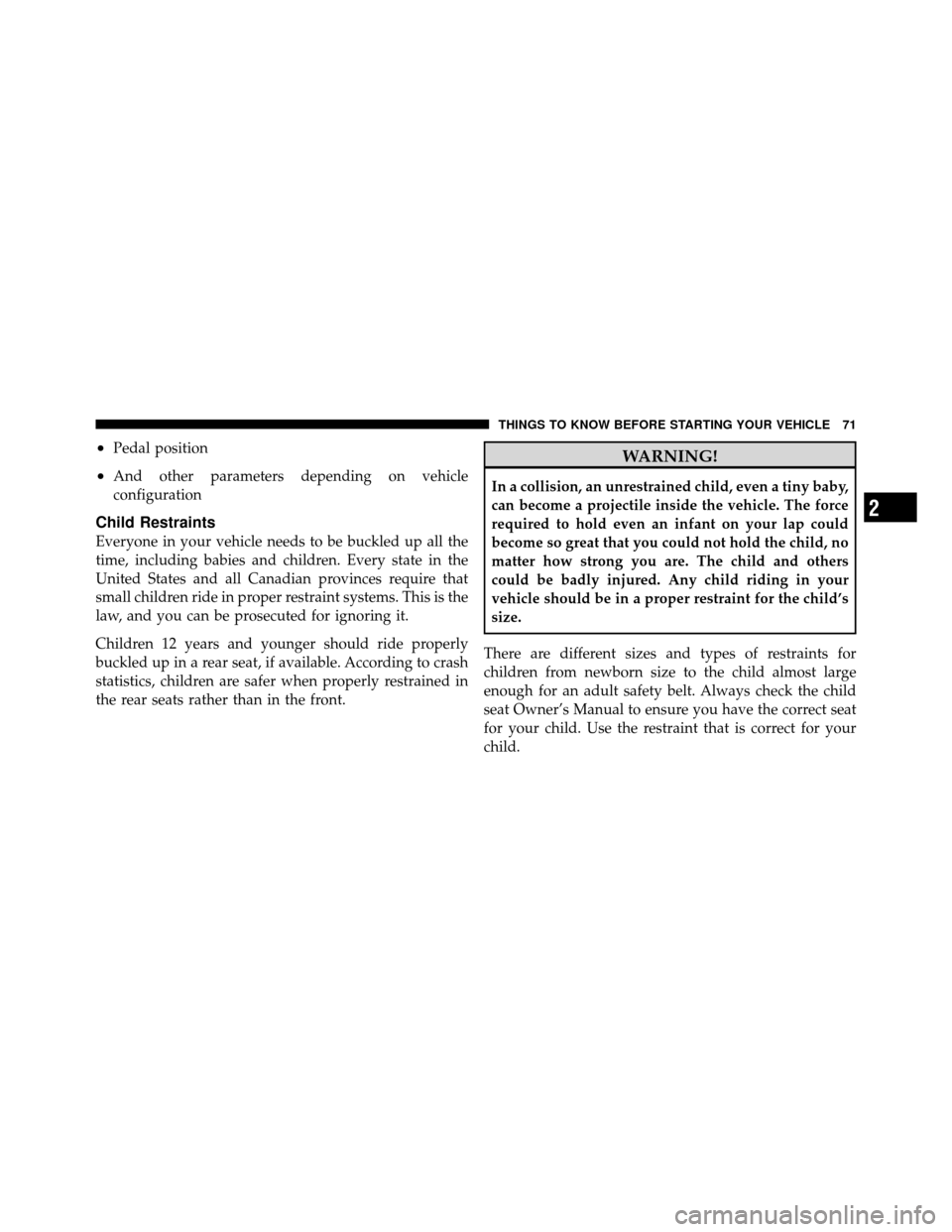
•Pedal position
•And other parameters depending on vehicle
configuration
Child Restraints
Everyone in your vehicle needs to be buckled up all the
time, including babies and children. Every state in the
United States and all Canadian provinces require that
small children ride in proper restraint systems. This is the
law, and you can be prosecuted for ignoring it.
Children 12 years and younger should ride properly
buckled up in a rear seat, if available. According to crash
statistics, children are safer when properly restrained in
the rear seats rather than in the front.
WARNING!
In a collision, an unrestrained child, even a tiny baby,
can become a projectile inside the vehicle. The force
required to hold even an infant on your lap could
become so great that you could not hold the child, no
matter how strong you are. The child and others
could be badly injured. Any child riding in your
vehicle should be in a proper restraint for the child’s
size.
There are different sizes and types of restraints for
children from newborn size to the child almost large
enough for an adult safety belt. Always check the child
seat Owner’s Manual to ensure you have the correct seat
for your child. Use the restraint that is correct for your
child.
2
THINGS TO KNOW BEFORE STARTING YOUR VEHICLE 71
Page 73 of 512
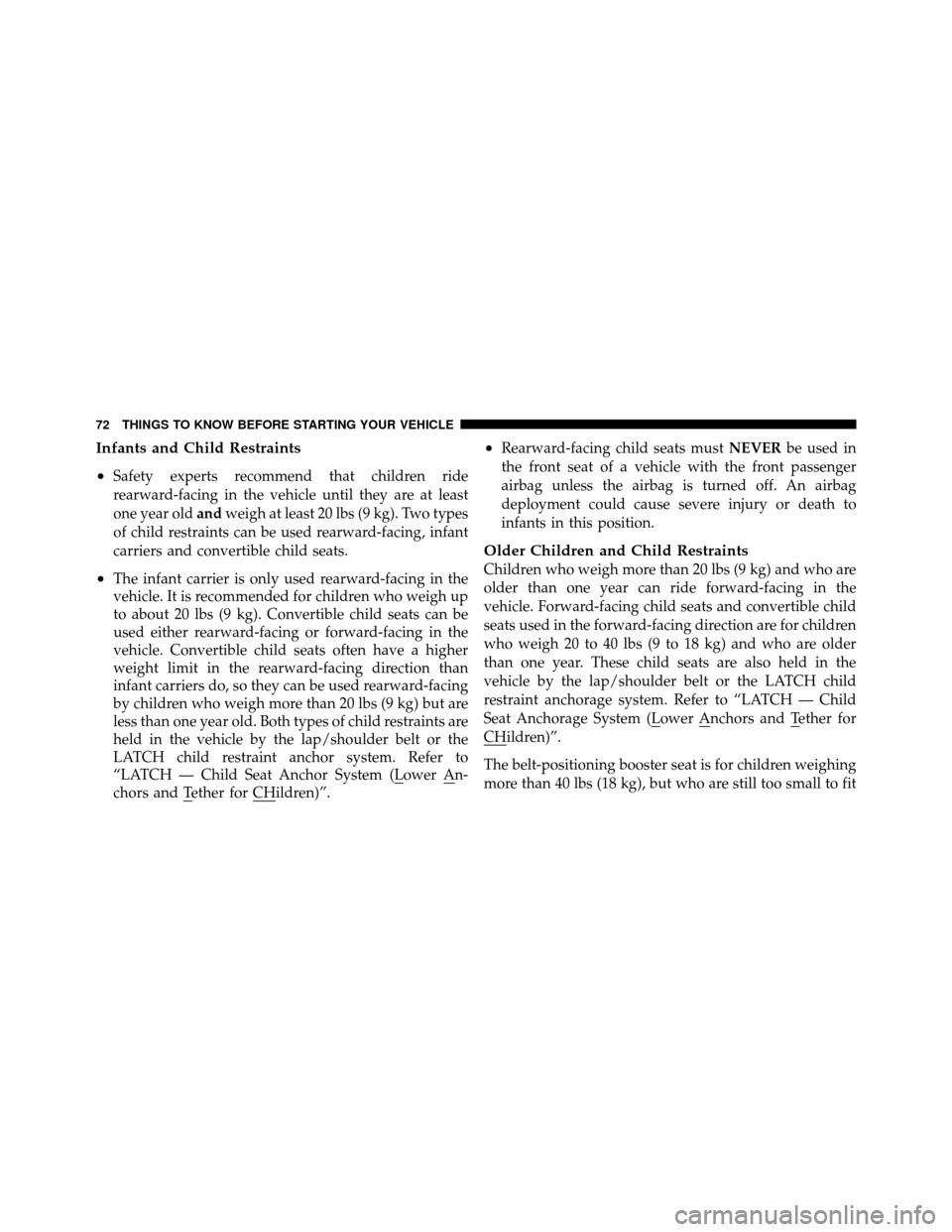
Infants and Child Restraints
•
Safety experts recommend that children ride
rearward-facing in the vehicle until they are at least
one year oldandweigh at least 20 lbs (9 kg). Two types
of child restraints can be used rearward-facing, infant
carriers and convertible child seats.
•The infant carrier is only used rearward-facing in the
vehicle. It is recommended for children who weigh up
to about 20 lbs (9 kg). Convertible child seats can be
used either rearward-facing or forward-facing in the
vehicle. Convertible child seats often have a higher
weight limit in the rearward-facing direction than
infant carriers do, so they can be used rearward-facing
by children who weigh more than 20 lbs (9 kg) but are
less than one year old. Both types of child restraints are
held in the vehicle by the lap/shoulder belt or the
LATCH child restraint anchor system. Refer to
“LATCH — Child Seat Anchor System (Lower An-
chors and Tether for CHildren)”.
•Rearward-facing child seats must NEVERbe used in
the front seat of a vehicle with the front passenger
airbag unless the airbag is turned off. An airbag
deployment could cause severe injury or death to
infants in this position.
Older Children and Child Restraints
Children who weigh more than 20 lbs (9 kg) and who are
older than one year can ride forward-facing in the
vehicle. Forward-facing child seats and convertible child
seats used in the forward-facing direction are for children
who weigh 20 to 40 lbs (9 to 18 kg) and who are older
than one year. These child seats are also held in the
vehicle by the lap/shoulder belt or the LATCH child
restraint anchorage system. Refer to “LATCH — Child
Seat Anchorage System (Lower Anchors and Tether for
CHildren)”.
The belt-positioning booster seat is for children weighing
more than 40 lbs (18 kg), but who are still too small to fit
72 THINGS TO KNOW BEFORE STARTING YOUR VEHICLE
Page 74 of 512
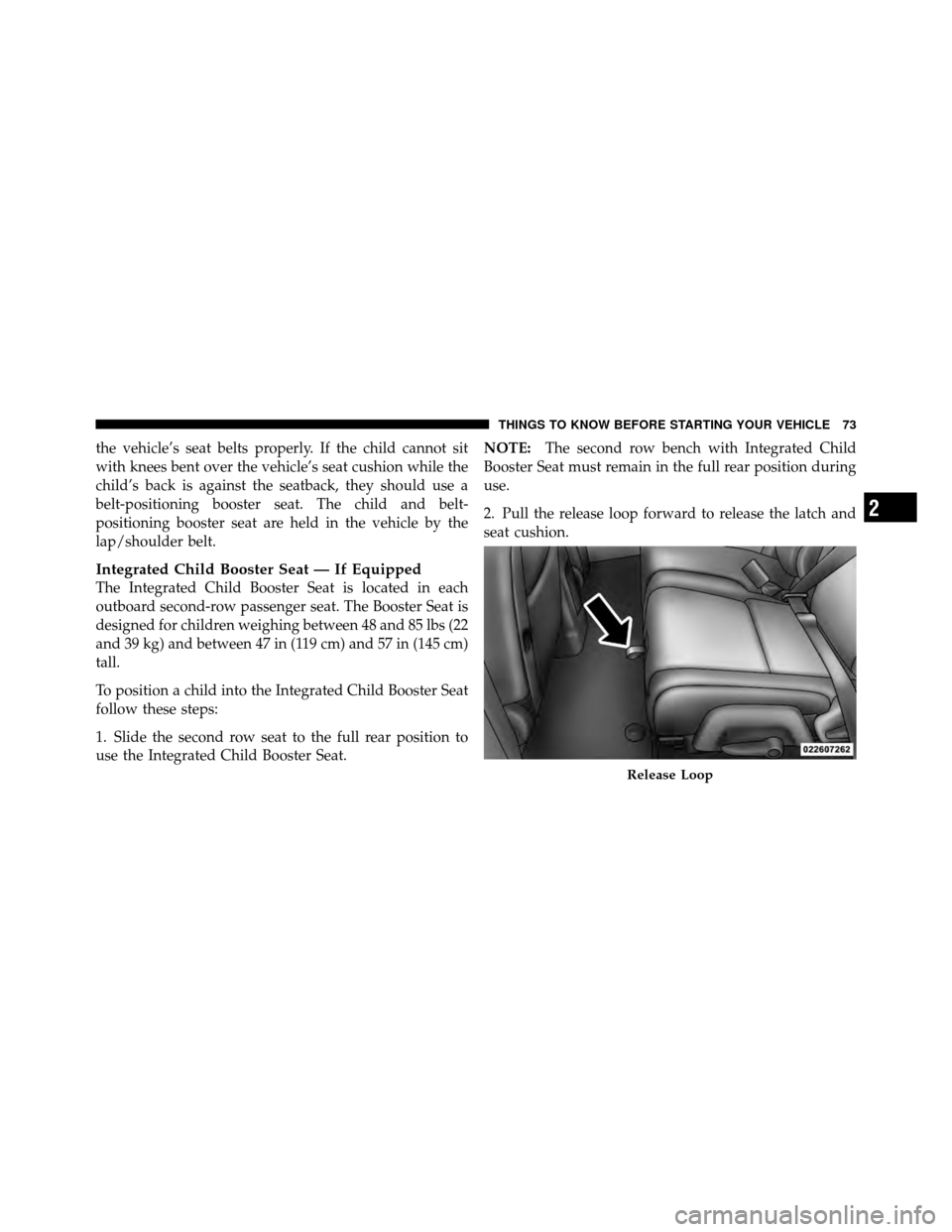
the vehicle’s seat belts properly. If the child cannot sit
with knees bent over the vehicle’s seat cushion while the
child’s back is against the seatback, they should use a
belt-positioning booster seat. The child and belt-
positioning booster seat are held in the vehicle by the
lap/shoulder belt.
Integrated Child Booster Seat — If Equipped
The Integrated Child Booster Seat is located in each
outboard second-row passenger seat. The Booster Seat is
designed for children weighing between 48 and 85 lbs (22
and 39 kg) and between 47 in (119 cm) and 57 in (145 cm)
tall.
To position a child into the Integrated Child Booster Seat
follow these steps:
1. Slide the second row seat to the full rear position to
use the Integrated Child Booster Seat.NOTE:
The second row bench with Integrated Child
Booster Seat must remain in the full rear position during
use.
2. Pull the release loop forward to release the latch and
seat cushion.
Release Loop
2
THINGS TO KNOW BEFORE STARTING YOUR VEHICLE 73
Page 75 of 512
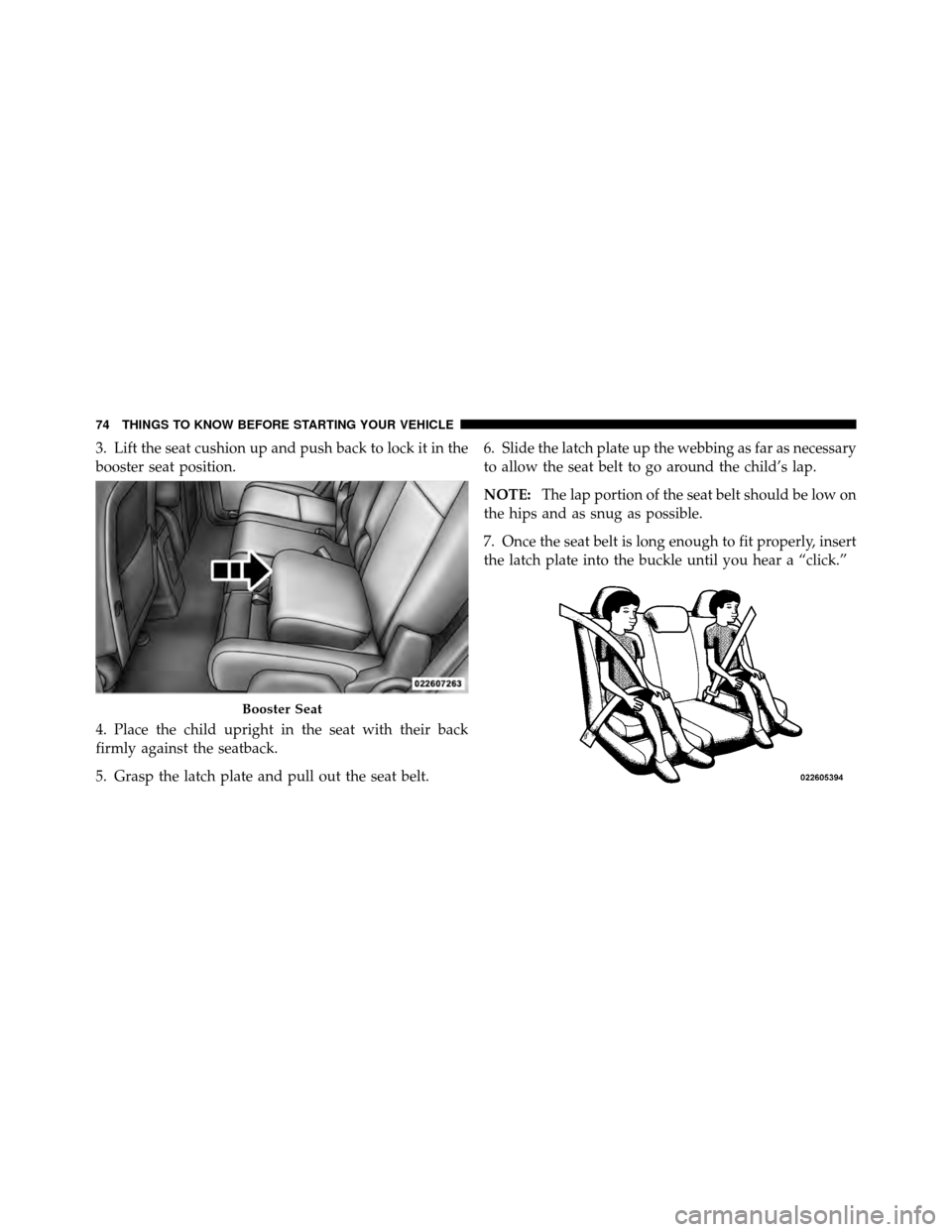
3. Lift the seat cushion up and push back to lock it in the
booster seat position.
4. Place the child upright in the seat with their back
firmly against the seatback.
5. Grasp the latch plate and pull out the seat belt.6. Slide the latch plate up the webbing as far as necessary
to allow the seat belt to go around the child’s lap.
NOTE:
The lap portion of the seat belt should be low on
the hips and as snug as possible.
7. Once the seat belt is long enough to fit properly, insert
the latch plate into the buckle until you hear a “click.”
Booster Seat
74 THINGS TO KNOW BEFORE STARTING YOUR VEHICLE
Page 76 of 512
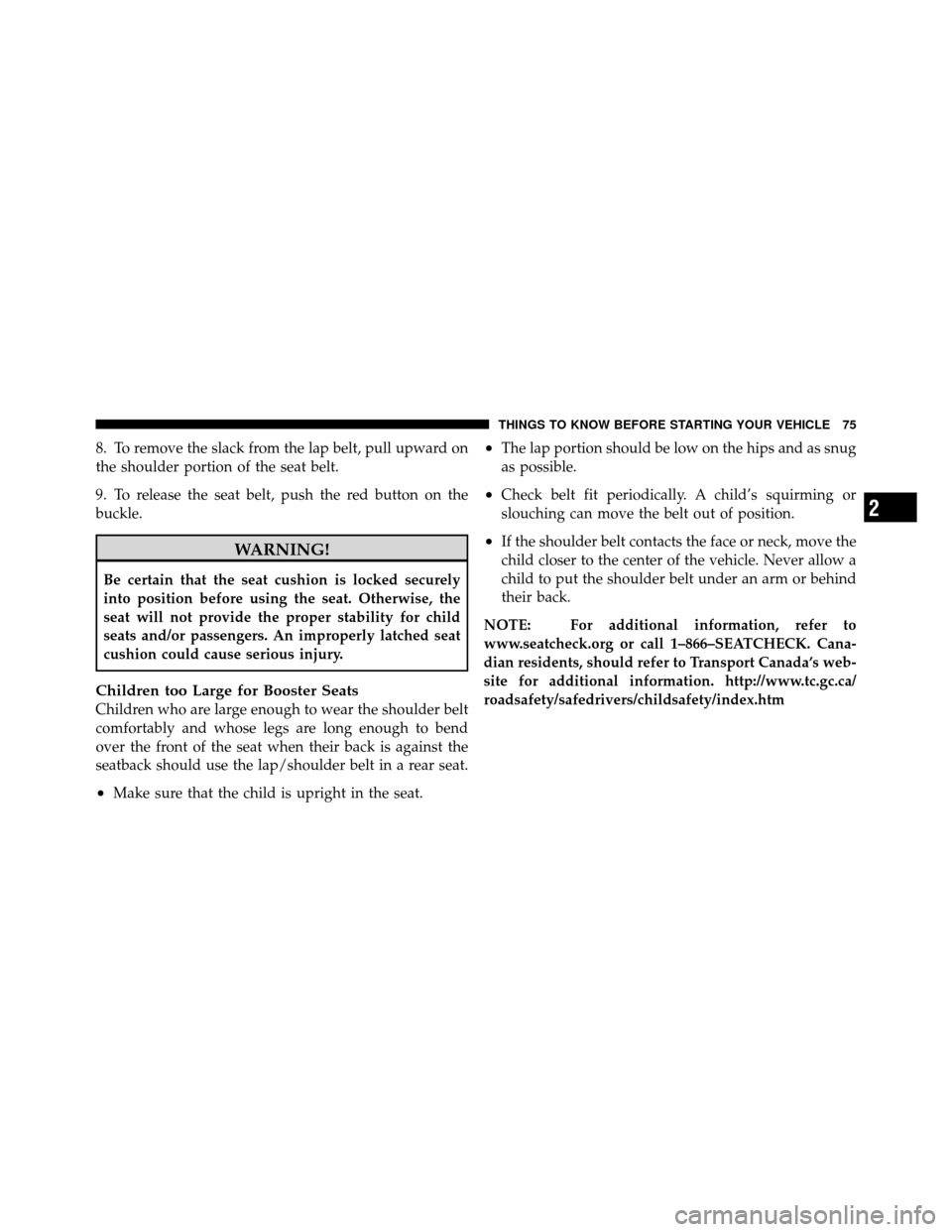
8. To remove the slack from the lap belt, pull upward on
the shoulder portion of the seat belt.
9. To release the seat belt, push the red button on the
buckle.
WARNING!
Be certain that the seat cushion is locked securely
into position before using the seat. Otherwise, the
seat will not provide the proper stability for child
seats and/or passengers. An improperly latched seat
cushion could cause serious injury.
Children too Large for Booster Seats
Children who are large enough to wear the shoulder belt
comfortably and whose legs are long enough to bend
over the front of the seat when their back is against the
seatback should use the lap/shoulder belt in a rear seat.
•Make sure that the child is upright in the seat.
•The lap portion should be low on the hips and as snug
as possible.
•Check belt fit periodically. A child’s squirming or
slouching can move the belt out of position.
•If the shoulder belt contacts the face or neck, move the
child closer to the center of the vehicle. Never allow a
child to put the shoulder belt under an arm or behind
their back.
NOTE: For additional information, refer to
www.seatcheck.org or call 1–866–SEATCHECK. Cana-
dian residents, should refer to Transport Canada’s web-
site for additional information. http://www.tc.gc.ca/
roadsafety/safedrivers/childsafety/index.htm
2
THINGS TO KNOW BEFORE STARTING YOUR VEHICLE 75
Page 77 of 512
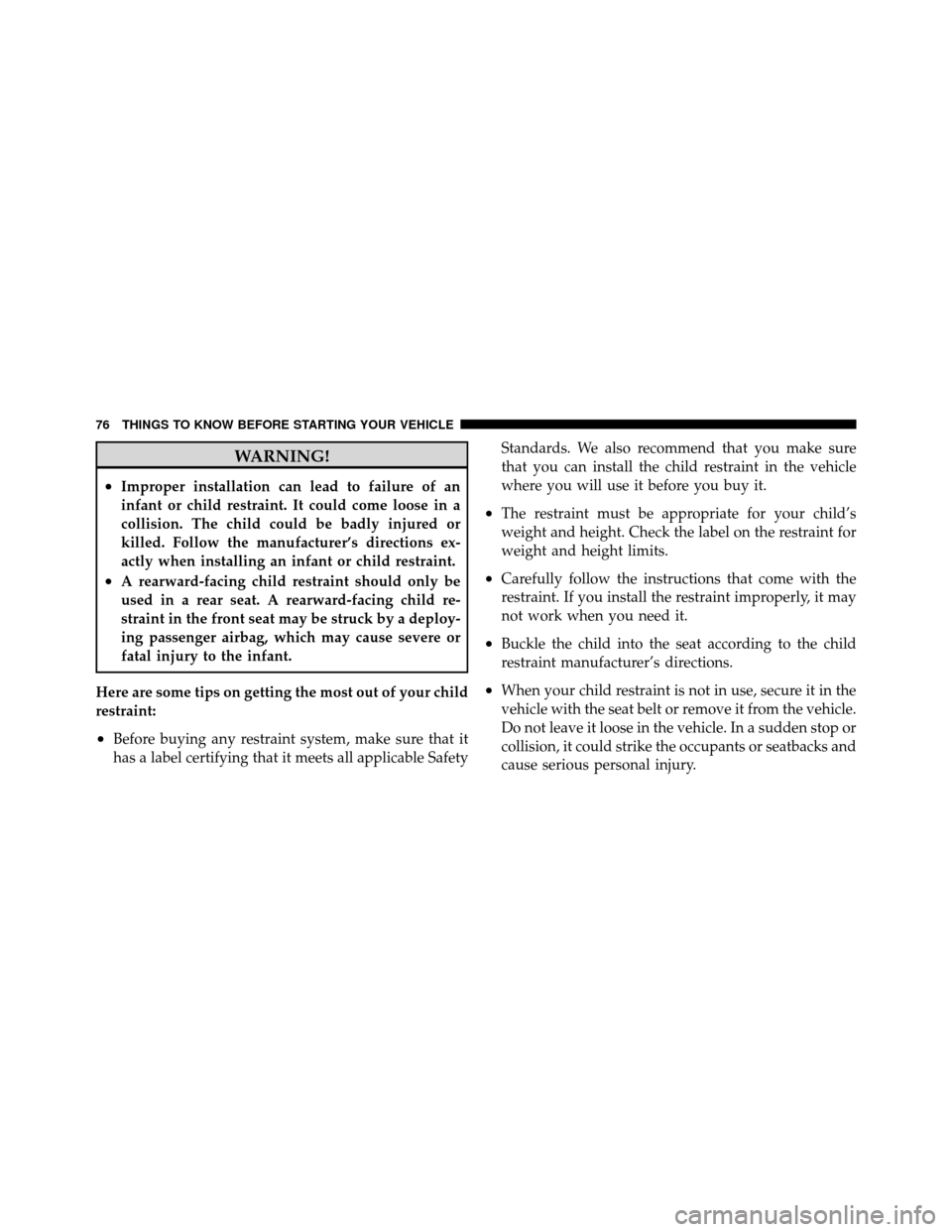
WARNING!
•Improper installation can lead to failure of an
infant or child restraint. It could come loose in a
collision. The child could be badly injured or
killed. Follow the manufacturer’s directions ex-
actly when installing an infant or child restraint.
•A rearward-facing child restraint should only be
used in a rear seat. A rearward-facing child re-
straint in the front seat may be struck by a deploy-
ing passenger airbag, which may cause severe or
fatal injury to the infant.
Here are some tips on getting the most out of your child
restraint:
•Before buying any restraint system, make sure that it
has a label certifying that it meets all applicable Safety Standards. We also recommend that you make sure
that you can install the child restraint in the vehicle
where you will use it before you buy it.
•The restraint must be appropriate for your child’s
weight and height. Check the label on the restraint for
weight and height limits.
•Carefully follow the instructions that come with the
restraint. If you install the restraint improperly, it may
not work when you need it.
•Buckle the child into the seat according to the child
restraint manufacturer’s directions.
•When your child restraint is not in use, secure it in the
vehicle with the seat belt or remove it from the vehicle.
Do not leave it loose in the vehicle. In a sudden stop or
collision, it could strike the occupants or seatbacks and
cause serious personal injury.
76 THINGS TO KNOW BEFORE STARTING YOUR VEHICLE
Page 78 of 512
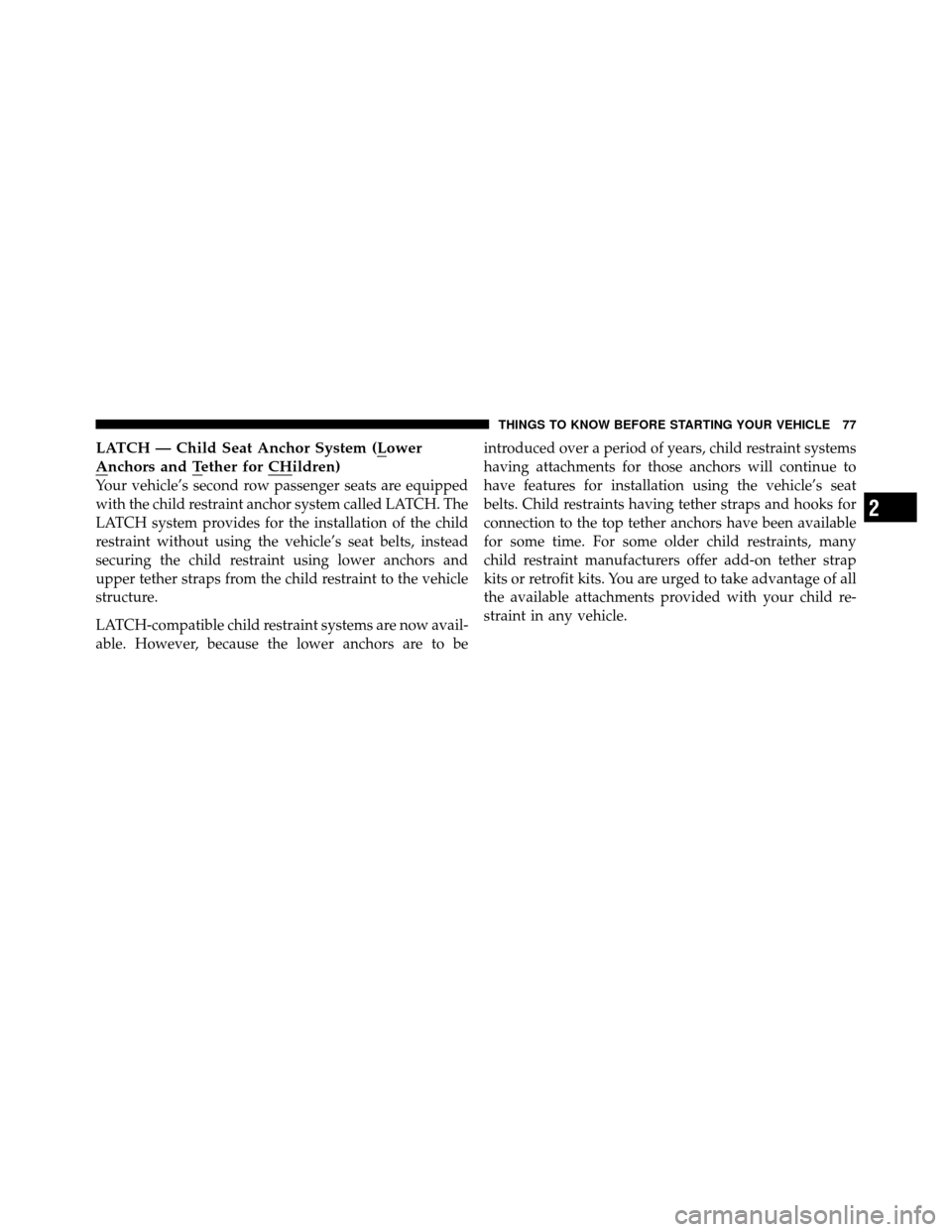
LATCH — Child Seat Anchor System (Lower
Anchors and Tether for CHildren)
Your vehicle’s second row passenger seats are equipped
with the child restraint anchor system called LATCH. The
LATCH system provides for the installation of the child
restraint without using the vehicle’s seat belts, instead
securing the child restraint using lower anchors and
upper tether straps from the child restraint to the vehicle
structure.
LATCH-compatible child restraint systems are now avail-
able. However, because the lower anchors are to beintroduced over a period of years, child restraint systems
having attachments for those anchors will continue to
have features for installation using the vehicle’s seat
belts. Child restraints having tether straps and hooks for
connection to the top tether anchors have been available
for some time. For some older child restraints, many
child restraint manufacturers offer add-on tether strap
kits or retrofit kits. You are urged to take advantage of all
the available attachments provided with your child re-
straint in any vehicle.
2
THINGS TO KNOW BEFORE STARTING YOUR VEHICLE 77
Page 79 of 512
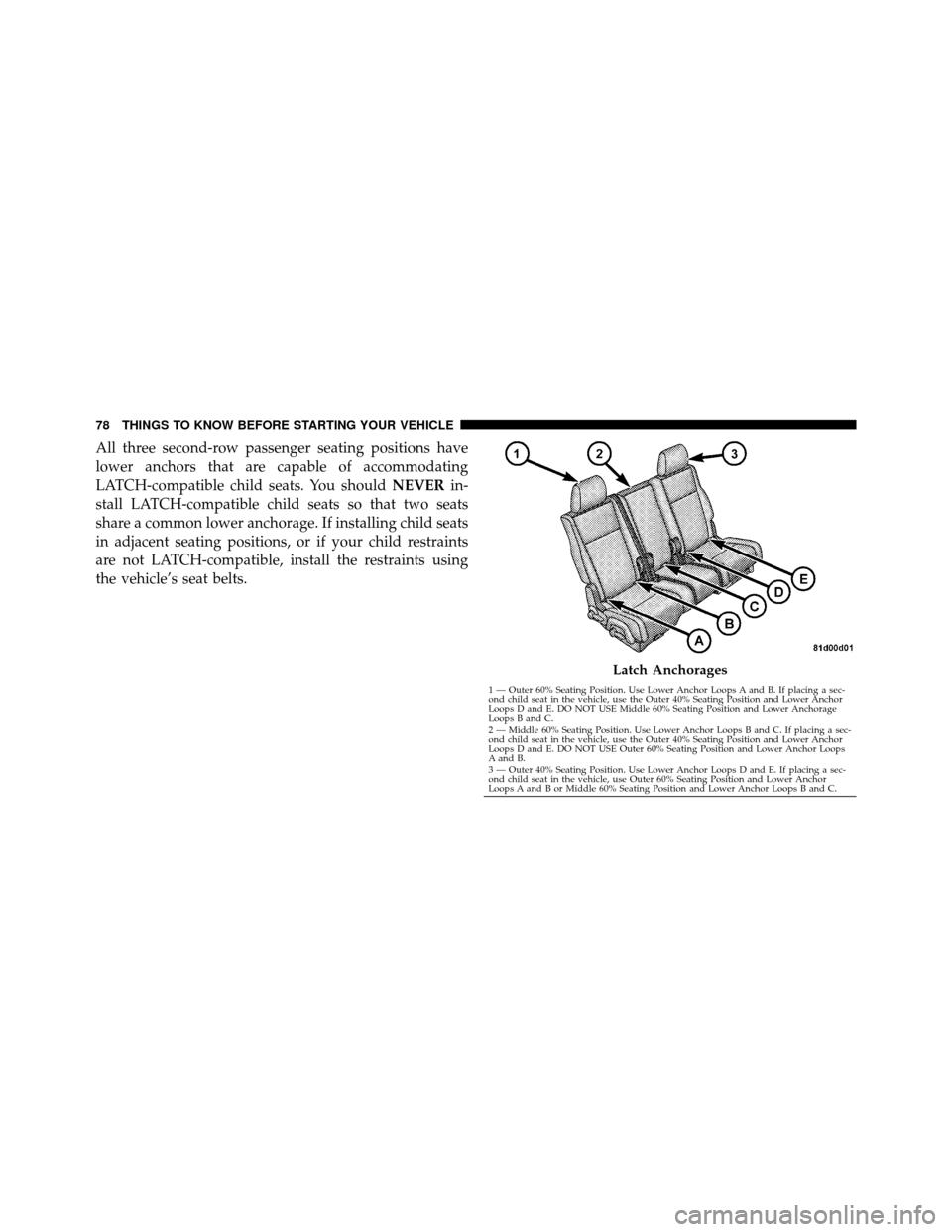
All three second-row passenger seating positions have
lower anchors that are capable of accommodating
LATCH-compatible child seats. You shouldNEVERin-
stall LATCH-compatible child seats so that two seats
share a common lower anchorage. If installing child seats
in adjacent seating positions, or if your child restraints
are not LATCH-compatible, install the restraints using
the vehicle’s seat belts.
Latch Anchorages
1 — Outer 60% Seating Position. Use Lower Anchor Loops A and B. If placing a sec-
ond child seat in the vehicle, use the Outer 40% Seating Position and Lower Anchor
Loops D and E. DO NOT USE Middle 60% Seating Position and Lower Anchorage
Loops B and C.
2 — Middle 60% Seating Position. Use Lower Anchor Loops B and C. If placing a sec-
ond child seat in the vehicle, use the Outer 40% Seating Position and Lower Anchor
Loops D and E. DO NOT USE Outer 60% Seating Position and Lower Anchor Loops
A and B.
3 — Outer 40% Seating Position. Use Lower Anchor Loops D and E. If placing a sec-
ond child seat in the vehicle, use Outer 60% Seating Position and Lower Anchor
Loops A and B or Middle 60% Seating Position and Lower Anchor Loops B and C.
78 THINGS TO KNOW BEFORE STARTING YOUR VEHICLE
Page 80 of 512
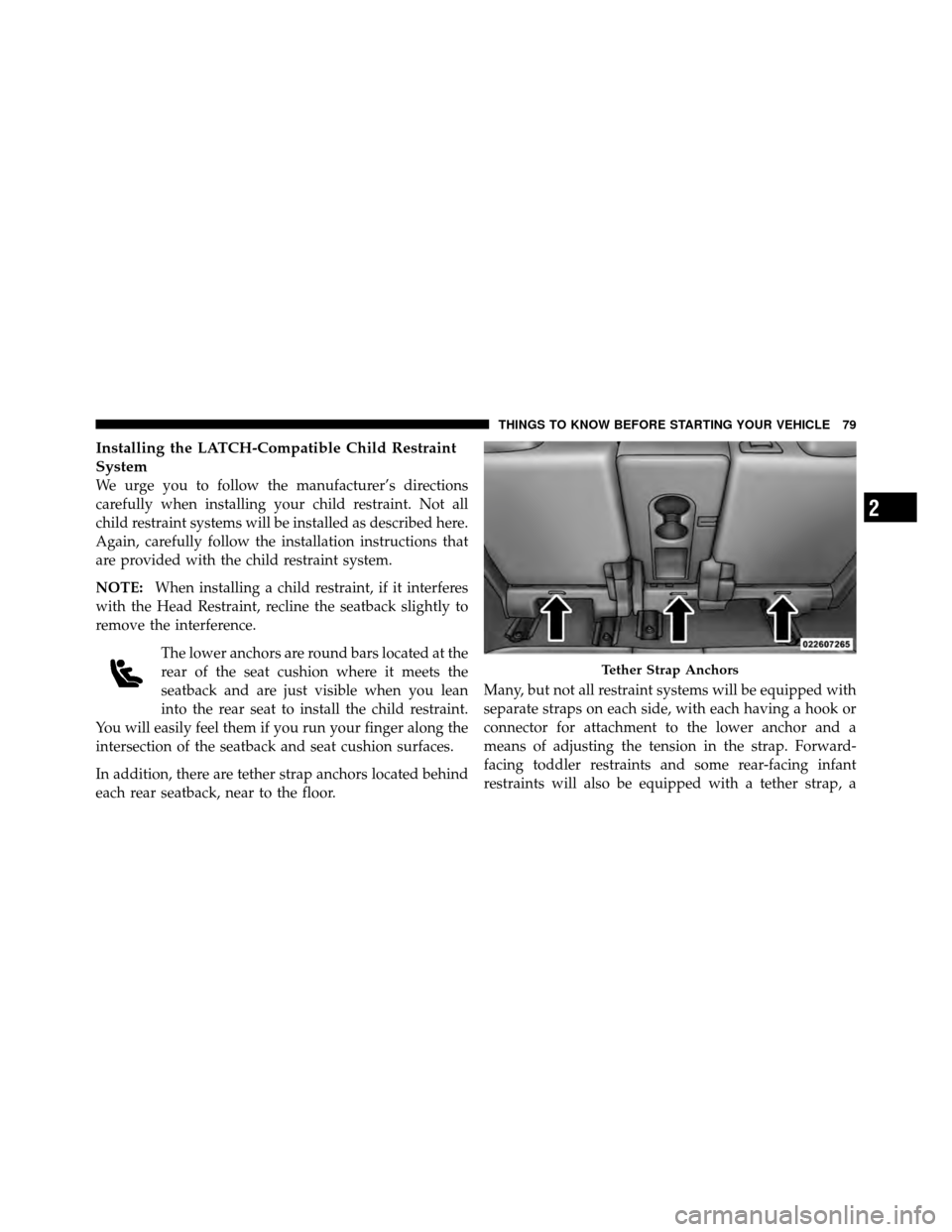
Installing the LATCH-Compatible Child Restraint
System
We urge you to follow the manufacturer’s directions
carefully when installing your child restraint. Not all
child restraint systems will be installed as described here.
Again, carefully follow the installation instructions that
are provided with the child restraint system.
NOTE:When installing a child restraint, if it interferes
with the Head Restraint, recline the seatback slightly to
remove the interference.
The lower anchors are round bars located at the
rear of the seat cushion where it meets the
seatback and are just visible when you lean
into the rear seat to install the child restraint.
You will easily feel them if you run your finger along the
intersection of the seatback and seat cushion surfaces.
In addition, there are tether strap anchors located behind
each rear seatback, near to the floor. Many, but not all restraint systems will be equipped with
separate straps on each side, with each having a hook or
connector for attachment to the lower anchor and a
means of adjusting the tension in the strap. Forward-
facing toddler restraints and some rear-facing infant
restraints will also be equipped with a tether strap, a
Tether Strap Anchors
2
THINGS TO KNOW BEFORE STARTING YOUR VEHICLE 79